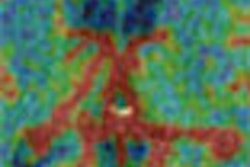How many cases should a physician perform to establish competence in cardiovascular CT or MRI? The American College of Radiology (ACR) has moved quickly to come up with some answers, no doubt hoping that policymakers and payors will take notice.
Given that organized medicine issues such guidelines frequently, the appearance of another new set may seem underwhelming. But a confluence of factors places greater significance on the ACR's newly published "Clinical Statement on Noninvasive Cardiac Imaging" (Radiology, June 2005, Vol. 235:3, pp. 723-727).
For one thing, the new statement specifies some minimums for hours in training and case volume that radiologists should achieve in cardiac MR and CT. And any numbers set for busy rank-and-file radiologists are a highly charged issue -- "like grabbing the third rail," according to ACR Chairman Dr. James Borgstede.
But, Borgstede said, "this is an example of what we're all going to have to deal with as practices advance into the new millennium. Numbers are what the public wants to see. They want to know that their physician can practice with skill and safety."
Maintaining a proficiency in the heart presents a particular challenge for general radiologists because other imaging in that area -- nuclear, echo, and conventional angiography -- has been largely taken over by cardiologists.
But organized radiology is working to prevent a similar ceding of cardiac CT and MRI at a time when those modalities are generating greater interest in cardiology. A categorical course in cardiac imaging was a huge draw for radiologists attending the most recent meeting of the American Roentgen Ray Society in New Orleans.
Also affecting the landscape is the general battle over high-end imaging that has pitted the ACR against essentially all other specialties, led by the well-organized and vocal American College of Cardiology.
In particular, the ACR has provoked other specialties by advocating the adoption of standards that would arguably limit the performance of imaging by nonradiologists.
Of course, arguing for standards is best accomplished by having standards in place. Hence, although the college has developed numerous practice guidelines over the years, a gap in cardiac imaging was quickly filled by a "statement" developed without the formalities of an official ACR practice guideline.
"There's been a lot of political tension, and I think that accelerated things," acknowledged Dr. Arthur Stillman, head of cardiovascular MRI at the Cleveland Clinic and a member of the ad hoc committee behind the new statement.
"We thought it would be worthwhile if we could address this issue; that's why this group was formed," Borgstede said. "This is the recommendation of these individuals in this task force, and it is very likely that a proposal will at some point in time be brought back to the (ACR) Council for validation and discussion with respect to policy."
There will also likely be competing standards put forward soon by other medical groups, Borgstede noted. "Many organizations are going to be involved in this, and certainly the college wants to step up to the plate and be part of that," he said.
The ACR's statement includes recommendations for technologists, equipment, and safety in the performance of cardiac CT and MR.
Meanwhile, the recommended standards for interpretation are predicated on a starting point of board certification in radiology or completion of an approved radiology residency.
To establish and maintain competence for cardiac MR, or for cardiac CT exams that are more than calcium scoring, the statement advises:
Supervising and interpreting a minimum of 75 cardiac cases in the chosen modality every 36 months.
Completing at least 40 hours of category 1 CME in cardiac imaging, including anatomy, physiology, and/or pathology, and in the chosen modality, or documented equivalent supervised experience in a center actively performing cardiac imaging in the selected modality.
The standards for radiologists in cardiac MR appear to be the same as previously outlined in the 2002 "ACR Practice Guideline for the Performance of Cardiovascular Magnetic Resonance Imaging." A more recent guideline for CT angiography posted on the ACR Web site doesn't appear to specify minimum case requirements.
Stillman expects hospitals and third-party payors may begin to require radiologists to meet the standards in the latest statement. The ACR is developing tools to enable completion of the supervised cases in an online format, he noted.
And while the standards were developed by a panel of academics, Stillman suggested that realistic expectations were paramount in setting the numbers. "The standards need to exist," he sad, "but they can't be so onerous that nobody can do them."
By Tracie L. Thompson
AuntMinnie.com staff writer
June 6, 2005
Related Reading
ACR hones strategies to retain radiology's role, May 17, 2005
ACC, ACR debate stats on imaging growth, April 18, 2005
U.S. Congress hears debate over federal imaging standards, March 17, 2005
Cardiac CT societies merge, as field's golden age dawns, March 9, 2005
Radiologists (mostly) cheer as insurers set imaging rules, November 4, 2004
Copyright © 2005 AuntMinnie.com




















